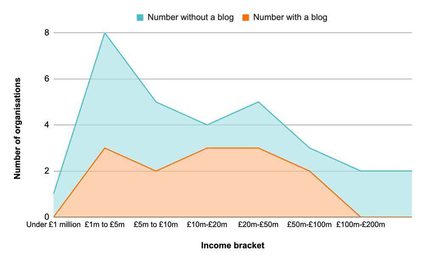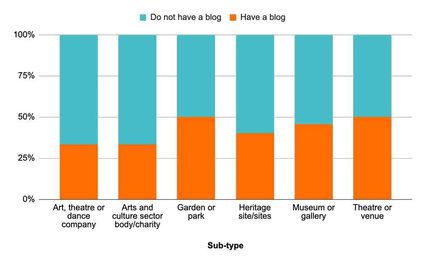What’s a blog for in 2023?
By content strategist Lauren Pope – based on her Supercool Session
A blog used to be an ubiquitous part of any arts and cultural organisation’s website. But that’s changing.
10 to 15 years ago, the blog boomed. It was part of the furniture of a website. Almost every arts and cultural organisation had one sitting in its nav bar, alongside the What’s on, Visit, or About Us section.
That popularity came with good reason: It was an easy content type to implement. Bloggers were being hyped the way YouTubers and TikTokers are now. To those still operating with a media mindset, blog posts seemed ‘free’ in comparison to advertising. Blogging promised limitless free traffic through organic search if you targeted the right keywords. It could solve a lot of pesky content problems too, like where to put the things that didn’t fit anywhere else. Plus blog posts were great fodder for all those new Facebook pages and Twitter feeds.
But things have changed. The way audiences consume and engage with content is different to how it was 10 or 15 years ago. The way we understand, use, and create content has changed too. And the blog seems to be falling out of favour as a result.
My study
I was curious about the state of blogging in the sector, so I carried out a study of 30 different arts and cultural organisations. I classified them into sub-groups of organisations who carry out similar activities, and looked at their websites to record data about their blog. I’ve chosen not to share the names of any of the organisations in the survey, apart from those who I think are doing the best job. I don’t want anyone to feel named and shamed – it’s not the point of this exercise.
In this post, I share my findings, along with some common mistakes, best practice, and content formats that you might want to consider as an alternative.
Findings from the study
- Only 13 of the 30 organisations have a 'blog'
- Findability and usability are problem areas
- Most organisations have one blog with multiple categories
- Some sites have content going back over a decade
- The average organisation publishes 25 posts a year
- Organisations are showcasing expert staff
- Announcements were the most common type of blog post
Finding 1:
Only 13 of the 30 organisations have a 'blog'
For the purposes of the survey, I let organisations self-define. If they called it a blog, I counted it as a blog. If they called it something else (News, Latest, Stories etc.) I didn’t count it as a blog. By that metric, only 13 of the 30 organisations have a blog.
I had a hunch that it might be larger organisations with bigger budgets that were leaving blogging behind. But actually, organisations with larger incomes were only slightly less likely to have a blog:

There wasn’t much of a trend when I looked at the types of organisation that had a blog either. Theatres and venues, and gardens and parks were most likely, followed by museums and galleries:

What is a blog, really?
As a blogging purist, I believe that for something to be a blog, it must:
- Be regularly updated with new posts
- Have a date on posts
- Have a named author for posts
- Focus on editorial, opinion-based, or personal content
So I also tested the blogs against this definition. I found that only four out of the 13 organisations with blogs perfectly matched it.
In a way, this brings me to the heart of why I’m so interested in the question of what blogging’s for in 2023.
Why are so many of us sticking with a blog, when what we’re doing isn’t really blogging and there are other content formats out there? That’s a theme I’m going to return to throughout this post as I share the other findings.
Finding 2:
Findability and usability are problem areas
It was surprisingly tough to find the blog homepage on many of the sites I included in the survey.
Only one organisation had its blog as a link in its main header menu. Four organisations linked the the blog from the footer. The others had it in various tucked away spots, some slightly connected to how they see the content, for example under news, media, or categories like ‘Inspire me’.
When I found the blog homepage, the usability features for exploring the posts were often poor. Many didn’t give you the option to filter, search, or sort posts in a meaningful way.
The issue: "Build it and they’ll come" is a myth
Build it and they’ll come is a myth for any type of website content – you always need to think about the distribution and findability. But this is especially true for blog content.
It’s most likely that you’ll be driving traffic to individual blog posts from email and social media. And people are unlikely to browse your site looking for your blog. So you might be wondering why it matters where you link to it from and how people explore the posts.
And up to a point, I agree with you. You have to prioritise the top tasks in your Information Architecture (IA), navigation, and homepage. But dumping the blog in the footer isn’t the answer. No one’s going to click the link down there, and all your hard work could go to waste.
Best practice: Think about how people will use the blog
Don’t hide your blog – think about the purpose and intention behind it, and try and fit it into the IA accordingly.
But this also brings me back to the wider issue: if you’re struggling to find a location for your blog on the site, it might be because it’s not what your users need.
Finding 3:
Most organisations have one blog with multiple categories
Only one of the organisations I looked at had more than one blog, and when I looked more closely, these were really just different categories rather than totally different entities. If you have or are tempted to have multiple blogs, check that you wouldn’t be better served by categories. I would only recommend having multiple blogs if they will have totally different audiences and purposes.
10 out of the 13 blogs I looked at used categories to break up their content into different themes or streams.
Issue: Too few or too many categories make navigation hard
Two organisations had no categories at all - just one long flow of posts. This makes it hard for users to narrow down to the particular thing they might be interested in.
At the other end of the scale, there was one blog with 17 different categories. It looked like people had added new ones over time with no real strategy or thought behind them. And unsurprisingly, lots of those categories hadn’t had a new post for months or even years. This is a frustrating experience for users too, leading them down a dead end to dusty content.
Best practice: Have a manageable number of evergreen categories with an organising principle
The average number of categories for the blogs I surveyed was six, which is a very sensible, manageable number.
You need to have an organising principle for your categories too. The most common ones in the survey were:
- Topic: like food and drink, volunteering, education
- Content type: e.g. interview, behind the scenes
- Content format: e.g. articles, videos, audio
I think content topic or type works best. It can help to think about it a bit like different regular things you’d have in a magazine, or parts of a Sunday paper. Whatever you choose, your categories should be evergreen and reflect your content strategy.
Finding 4:
Some sites have content going back over a decade
Four organisations had content going back more than a decade. Two went back to 2009, and one went back 16 years to 2007.
Issue: keeping content online has a carbon cost
That’s an awful lot of old posts that are incredibly unlikely to be getting any traffic. And keeping old blog posts online requires energy and will add to the carbon footprint of your site.
Best practice: delete or archive content after two years
As a general rule, I suggest keeping content for a maximum of two years before deleting it (or archiving it offline if there’s a good reason for you to do so).
When I do content audits for clients, there’s almost always one or two old blog posts that still get lots of traffic because they show up in a common search query. And this often sparks a debate about whether or not to archive that content.
I think old content that’s still getting traffic is a good indication that it should never have been a blog post in the first place. Look at that content and think about how to convert it into an evergreen format, and think about what it can tell you about evergreen content formats to explore for the future.
Finding 5:
The average organisation publishes 25 posts a year
The median number of blog posts published in 2022 was 25 – a little over two a month, which is not very much at all. The overall average was 51 posts, but this is skewed by a few very prolific posters.
The highest number of posts in 2022 was 181. It sounds like a lot, but it works out as an average of just over three posts a week. This organisation has a vast number of writers – 43 whose names start with ‘A’ alone – drawn from a huge pool of subject matter experts, which explains why it can be so prolific.
Issue: Posting infrequently means another format might be best
The least active blog shared just two posts in 2022. This organisation is an interesting case. All of its blog posts have a date on them, but they are evergreen in format – think historical stories and ideas for things to do on visits. And while it has a blog homepage where all these posts are collected, if you look at the URLs, they actually sit in the ‘Visit’ section of the site, and are linked from that part of the navigation too.
From an outside perspective, I’d say they should lose the blog and keep on publishing evergreen, undated content in the visit section of the site. That seems like it would be a much better strategic choice and more likely to generate results.
Best practice: Post regularly, and post ephemeral content or choose a different content type
If you’re going to have a blog, aim to post regularly – at least once a week – and focus on content with a shelf life.
If you don’t have time to post regularly, or you want to create content with a longer lifespan, you would probably be better off investing your time in evergreen content types.
Finding 6:
Organisations are showcasing expert staff
Eight of the 13 blogs showed the names of the people who were writing the posts. Among those who have named authors, there was a pretty wide range of people writing. Obviously there were lots of marketing and content people, but also curators, librarians, artists, directors, and other subject matter experts too. There were also a small number of organisations bringing in members of the public/community too.
Issue: People are probably your point of difference
Not naming your writers is a missed opportunity, and one of the key things that makes a blog a blog. People are interested in other people, so being able to put a face to a piece of writing can help with engagement.
Leaving all the writing to marketers is a missed opportunity too. And that’s not because there’s something wrong with marketers and their writing – far from it. It’s that arts and culture organisations have such a wealth of knowledge in curators, librarians, and other subject matter experts. Their knowledge can be a compelling point of difference for your content.
Best practice: Showcase people, try pair writing
Try to showcase the people in your organisation and all their knowledge.
I know that it’s not always that easy, and that people are busy, or lack skills/confidence when it comes to their writing. But that’s where pair writing comes in. Grab your expert, ask them questions for 30 minutes or an hour to write a draft together, and then ghost write the final post for them.
Finding 7:
Announcements were the most common type of blog post
I looked at the three most recent posts for each of the blogs, and then picked out the common content topics or themes. I found that:
- 26% were announcements (e.g. a new tour, exhibition, or event)
- 15% were ‘behind the scenes’ posts (e.g. collection restoration, or how different things are done at the organisation)
- 13% focused on giving information about a specific artist, maker, or other talent
- 10% were about social issues (e.g. sustainability)
- 10% were about history
- 8% were about the collection or programme
- 8% were interviews with artists, directors, performers, or other talent
I was happy to see so many ‘behind the scenes’ posts. This is a rich seam of unique content - only you have access to this information, and it’s often fascinating stuff. It’s a great opportunity to showcase expert staff too.
Issue: The blog is a dumping ground for content with no home!
This part of the survey brought me back to the crux of the issue with blogs. The ‘just stick it on the blog’ attitude was clear to see when I dug into the topic of the posts being shared. So many blogs are a dumping ground for content that someone wanted to publish that didn’t have a home elsewhere. The content that felt the most dumped fell into two categories for me: announcements, and collection or programme content.
Just over a quarter of the posts shared were announcements, on a very wide range of different topics. These posts are typically written from the perspective of the organisation, broadcasting out something that they want people to hear. I’d guess that 90% of this starts with a stakeholder saying ‘I need to tell x about y, can you put something on the website?’ and a weary content person muttering ‘Yeah sure, I can stick it on the blog’.
But this isn’t what a blog is for. The best content type for it would be news, but I’m increasingly sceptical that website content is the right way to get this content to your audience. ‘Build and they’ll come’ doesn’t work for websites. You need to push content like this out to people. If you’re doing that via email, the user would probably rather read the news in the email. And if you’re sharing on social, not only do users not want to click if they could get all the info there and then, but the platforms are increasingly hostile to off-site content.
Another big chunk of posts were about collections, programmes, or related history. Again, I don’t think the blog is the right place for this content. It’s evergreen with a long potential lifespan, while blog posts have a date on them and are ephemeral. And from a user's point of view, if they want to learn more about something related to your collection or programme, they’re much more likely to look for that content by topic than by content type.
Best practice: Choose the right content type for the job
What this all boils down to is choosing the right content type (and platform) for the job. Data will help you explore if blog posts are a good medium for announcements: how much traffic do those posts get, where does it come from, and what do people do next?
Think about duplication of effort too: do you really need a blog post announcing a new event or exhibition, or could you just use the event/exhibition page itself? If you’re making marketing content – like ‘Ten reasons to come and see/do x’ – could that be a sub-page for the specific event or exhibition instead of a blog post?
On the collection, history, and ‘behind the scenes’ side of things, explore your options for evergreen content types that mean you can make this content available in the long-term as part of however you represent these aspects on the website.
So, what are some alternatives?
I looked at what organisations that don’t have a blog have instead. All of them had some kind of content that overlapped with the things that the other organisations were putting on their blog.
News
11 of the organisations had a ‘News’ section. As I mentioned a moment ago, I think news is a better option than a blog if you have a lot of announcement-type content to share. But with a big caveat to check if this content is really getting the kind of response you want.
Stories
Six had something along the lines of stories, features, or articles, with stories being the most common way of naming this content. The organisations that had a ‘Stories’ section tended to be museums, galleries, or heritage site(s).
The content in these sections varied, but a lot of it was concerned with sharing stories about things in the collection, adding context to the collection, or exploring related topics and themes. Lots of the best blogs share this kind of content too, but I think there are two key differences to call out.
The first is that the name ‘Stories’, ‘History’ or similar variations gives users more of a hint about what to expect than ‘Blog’, and it promises a bit more interest too (everyone loves a story).
The second is that story content was often a primary category in the navigation, or a secondary category under something like ‘Discover’ or ‘Explore’. It felt like this was content that the organisations valued and wanted to promote - unlike the blogs which often felt like an afterthought, or even something the organisations were ashamed of.
One example I wanted to point out here was the Wellcome Collection’s ‘Stories’ section. It has the a really diverse range of content from a range of different internal and external writers, and adds a lot of additional context to the museum’s collection. I interviewed Dr Alice White, Digital Editor at the Wellcome Collection about their Story content a while ago and she told me that the team there took the view that ‘the website is the organisation, not just a way of funnelling people to the physical organisation’ and therefore they see their story content as a way to deliver on their mission to challenge how people think and feel about health: “We decided that one of the best ways to do that was through telling compelling stories and having the kind of narrative you might have if you walked through an exhibition.”
Email newsletters
While I didn’t look into this as part of the survey, I wanted to mention email newsletters (and podcasts) as an interesting format to consider when thinking about blogging. Content-based email newsletters have boomed over the last few years, and can be a great way to build a very engaged audience around high-quality, unique content.
Look at your evergreen content
The most important thing to take away from this is to think about your evergreen content and whether you have the right formats to support your content strategy.
If you’re just using the blog as digital storage for content that doesn’t have a home elsewhere and that has long-term relevance, you need new content types.
For galleries, libraries, archives and museums, this is all about finding the right content types to enable you to share content about your collection. It’s also a huge opportunity: you have an incredibly rich source of subject matter that someone out there is almost certainly using Google to search for.
For theatres, venues, and other organisations that are focused on a programme of exhibitions, events, shows, or seasons, this still applies, but needs to be executed in a slightly different way to reflect that your programme changes over time.
You can watch the full recording of Supercool Session #9 – "Just stick it on the blog" with Lauren Pope – including Q&A with the audience

Lauren Pope is an independent content strategist for charities, arts and culture organisations, and good businesses.
She’s worked in content and digital since 2007, and has delivered projects for some of the world’s biggest brands, including adidas, American Express, Microsoft and Tetra Pak. She started her own consultancy – La Pope – in 2018 to focus on helping organisations that put people and planet before profit tap into the benefits of content strategy.
? Sign-up now to get invitations to future Supercool Sessions webinars – plus Supercool's "brilliant, informative and entertaining" monthly newsletter
